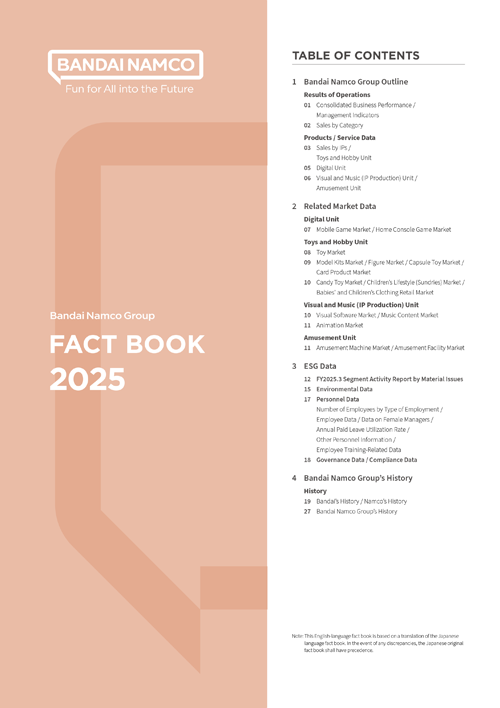
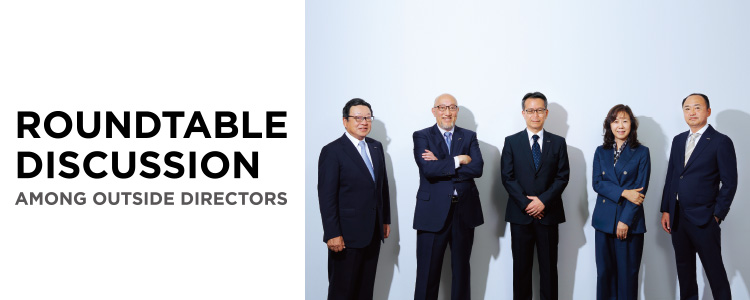
 ROUNDTABLE DISCUSSION AMONG THE OUTSIDE DIRECTORS
ROUNDTABLE DISCUSSION AMONG THE OUTSIDE DIRECTORS
needs of the market as we help push the Group into a new stage
of sustainable growth.
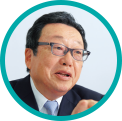 Toshio Shimada
Outside Director
Toshio Shimada
Outside Director
 Koichi Kawana
Outside Director
Koichi Kawana
Outside Director
 Toru Shinoda
Outside Director
Toru Shinoda
Outside Director Audit & Supervisory
Committee Member
 Satoko Kuwabara
Outside Director
Satoko Kuwabara
Outside DirectorAudit & Supervisory
Committee Member
 Takayuki Komiya
Outside Director
Takayuki Komiya
Outside DirectorAudit & Supervisory
Committee Member
 Evaluation of FY2025.3 Performance
Evaluation of FY2025.3 Performance
Shimada:The Company’s performance in FY2025.3 was outstanding. With that said, I am slightly concerned with just how much the initial forecasts at the beginning of FY2025.3 were exceeded. When performance forecasts are too conservative, this can cause issues in communication with investors. I also believe that the Company needs to focus on how the Digital Business will change under the revised development structure, as it is highly volatile.
Kawana:What is even more impressive than the Company's overall performance is the fact that all business segments saw sales and profit growth, the Group was able to be strengthened as a whole, and collaboration was enhanced across businesses. I believe we are starting to see the results of the various growth-oriented initiatives implemented in each business. We are also starting to see the results from a series of reforms in the Digital Business, including the revision of the development structure and investment approach.
Shinoda:The Group’s diverse business portfolio has underpinned its rapid growth in recent years. By bringing together the collective strengths of the Group to deliver products that provide value to its fans, it has built a stable earnings base. While I generally agree with the reforms in the Digital Business, which involve shifting the focus to highly successful games in areas that leverage Group strengths, I also would like to see this business take on challenges in entirely new fields.
Kuwabara:The final year of the previous Mid-term Plan ended on an extremely high note, including the recording of a record-high performance in the Toys and Hobby Business for the seventh consecutive fiscal year. In addition, the Company was able to raise the level of operating profit compared with that of past Mid-term Plans. I commend the Company for these accomplishments. The Company also refined its strategic approach in the Digital Business based on title portfolio management. Meanwhile, given the inherently long lead times in game development, it will likely take some time before we begin to see real results from these reforms, so in the meantime,I would like to closely monitor how the new development structure balances with creativity.
Komiya:I think it is incredible that the Group has achieved overall growth in sales and profit and has continued to trend upward nearly uninterrupted for over 10 years. With regard to the Digital Business, I believe that steady progress is being made with structural reforms in response to longer development periods and cost increases. This progress includes managing development schedules with an awareness of project scale, controlling investments, and making forecasts based on the results achieved with similar projects.
 Mid-term Plan and Long-term Vision
Mid-term Plan and Long-term Vision
Shimada:The Mid- to Long-term Vision under our current Mid-term Plan represents an evolved and enhanced version of the Mid-term Vision under the previous Mid-term Plan. With this move, we now need to address the issue of how to approach an even longer-term vision. By repeatedly carrying out efforts to deal with the circumstances at the time, we have achieved medium- to long-term outcomes. However, when considering dialogues with capital markets and the need to prepare for significant change in the operating environment in the future, I think we would benefit from adopting a backcasting approach, where we consider our future vision and then work backward from there. To that end, I hope that we can deepen our discussions on long-term topics while keeping in mind the uncertainty of the current era and the differences in business life cycles.
Kawana:By exporting IPs, anime, and games, the Group is making efforts to realize value creation from Japan on a global stage. These efforts enhance the international appeal of Japan and ultimately contribute to national interests. I therefore want Group employees to take pride in the work that they do, and I think the longer-term vision plays an important role in fostering such a mindset.
Shinoda:When formulating the Group’s Purpose, we held repeated discussions on our vision for the Group 10 years from now at venues such as Vision Meetings and executive off-site meetings. Of course, it is important to consider the Group’s long-term direction. However, issues that span the long term cannot necessarily be determined all at once. Rather, I think it would be best for us to incorporate an awareness of long-term issues in our Mid-term Plans and then build strategies from there.
Kuwabara:At the moment, our discussions have focused on the current Mid-term Plan. However, many initiatives of the plan, such as 360 investments and our approach to sustainability, incorporate long-term perspectives. By continuing to engage in discussions on such initiatives, I hope we can help contribute to the development of an even longer-term vision.
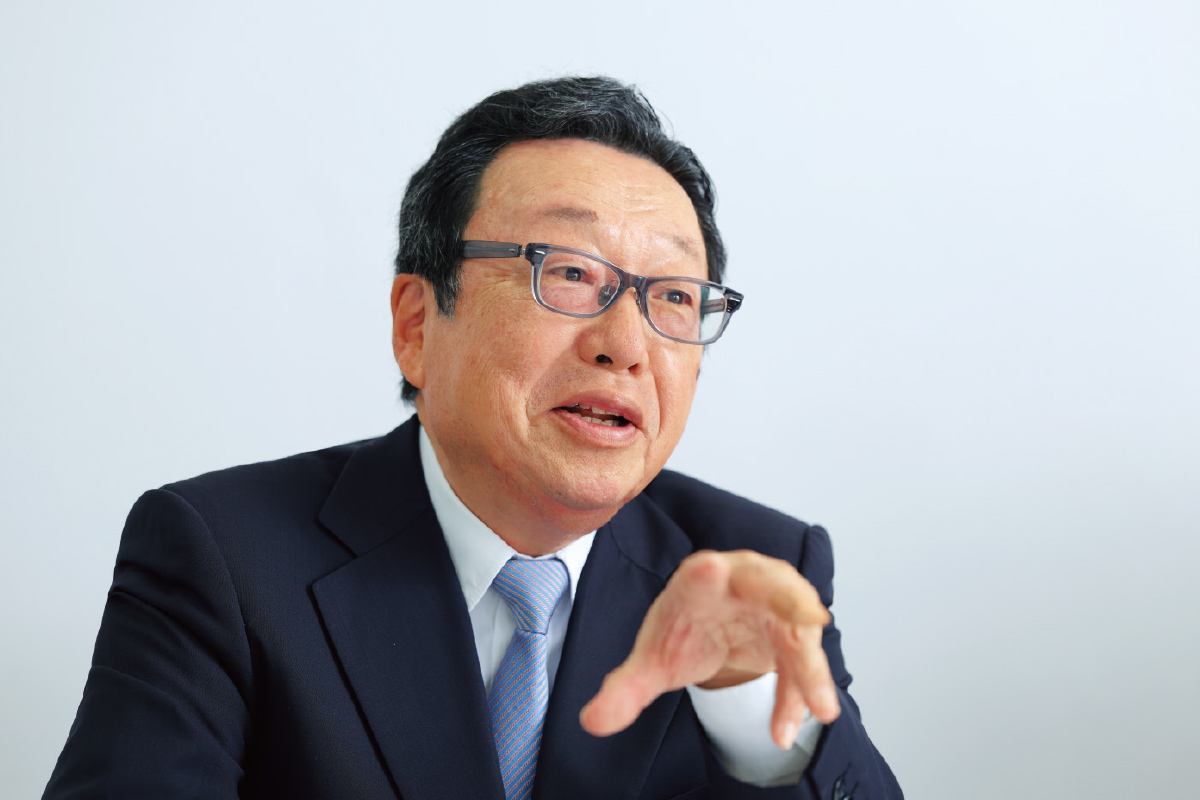
 Global Risk Management
Global Risk Management
Shimada:Excluding uncontrollable geopolitical factors, the challenges and risks facing the Group can be divided into four categories: recruitment of overseas management talent, enhancement of corporate functions, the advancement of AI, and information security. The first two categories are pressing issues that, if resolved, can support the Group’s rapid business growth. Regarding the third category the rapid evolution of AI over the upcoming three years has the potential to create new markets. Finally, with regard to the final category we need to step up communication from management and division heads in order to enhance the overall level of information security awareness among Group employees. Without knowing what tomorrow may bring, it is important that we maintain a sense of urgency and always keep in mind both preventive and post-incident response measures.
Kawana:We naturally face risks when pursuing new challenges. For this reason, we should adopt an approach that encourages and supports the execution side based on sound risk management. To do so, it is crucial that we maintain an awareness of risks and identify them accordingly through the Group Risk Management Committee and work to ascertain their frequency and severity. We also need to hold regular discussions on multiple business continuity plans in preparation for the unexpected. The key to all of these efforts is embracing the diverse perspectives and approaches of our diverse personnel, including outside directors.
Shinoda:The enhancement of corporate function and information security are two urgent issues, particularly at our overseas offices, where corporate functions are not always firmly established. To address these issues, the Audit & Supervisory Committee conducted an audit in FY2025.3 focused on information security. By expanding local information security systems and conducting ongoing audits, we will strengthen our response to information security with a sense of urgency.
Kuwabara:There are instances when the Group’s rapid business growth has outpaced efforts to strengthen corporate functions. Looking ahead, it is crucial that overseas operations are approached with a clear awareness of the issues at hand. In addition to strengthening the structure for local talent, efforts to cultivate talent on a global scale must be bolstered. To that end,I intend to pay particular attention to the rotation of management personnel.
Komiya:Preventing and responding to scandals are matters closely tied to a company’s corporate culture. Taking into account the increasing risks following the global expansion of the Company’s offices and personnel as well as reputational risks brought about by the widespread use of social media, the Company must strengthen countermeasures while drawing on examples from other companies when appropriate.
For this reason, we should adopt an approach that encourages and supports the execution side based on sound risk management.

 Commencement of a New Management Structure
Commencement of a New Management Structure
Shimada:In the selection process for President Yuji Asako, the Personnel Committee reviewed and provided input on the candidate proposed by the executive side. Mr. Asako, who was a director at the time, was deemed suitable for the position because of his experience to date and in consideration of the Company’s efforts to strengthen corporate functions and adopt a management approach better oriented to capital markets. Afterward and once again holding interviews with Mr. Asako himself, we reached the conclusion as a committee that he was well-suited to be the next president of the Company.
Kawana:The selection and dismissal of the CEO is a fundamental part of governance. At meetings of the Personnel Committee, we exchanged various opinions with the executive side. Through these exchanges, we determined that Mr. Asako was well-suited for the role of formulating new growth strategies, which are backed by the Company’s capital strategies.
In addition, we were told that then-Director Nobuhiko Momoi, who has a deep understanding of our business operations and extensive experience overseas, was being considered for the role of vice president. After holding multiple interviews with both individuals, we determined that the best course of action would be to entrust these two individuals with the future of the Group’s management while providing them with support from behind the scenes.
Kuwabara:We asked the executive side to explain their reasons and the basic approach behind their proposals, and after conducting multiple interviews, we reached a satisfying conclusion regarding the appointments. Mr. Asako has experience in the Company’s corporate divisions and has demonstrated strong leadership in formulating financial strategies, communicating with investors, and implementing M&A policies. Meanwhile, Mr. Momoi has gained extensive experience in both domestic and overseas business operations, giving him a cross-organizational perspective that goes beyond individual business Units. Accordingly, I am very pleased with their appointments as president and vice president.
Shimada:Leaders of business Units generally focus on optimizing operations in their own respective Units. However, by combining the strengths of Mr. Momoi—who has a broad perspective on the market and the Group’s future as well as a thorough understanding of frontline issues—with Mr. Asako’s vast expertise in back-office functions, we believe they will form an outstanding management team.
Kawana:Executive Vice President Momoi has a unique personality, excellent communication skills, and a drive for taking action. I look forward to his serving as an ambassador who shares the passion of Bandai Namco with the world as well as a pioneer who forges new paths through unexplored areas.
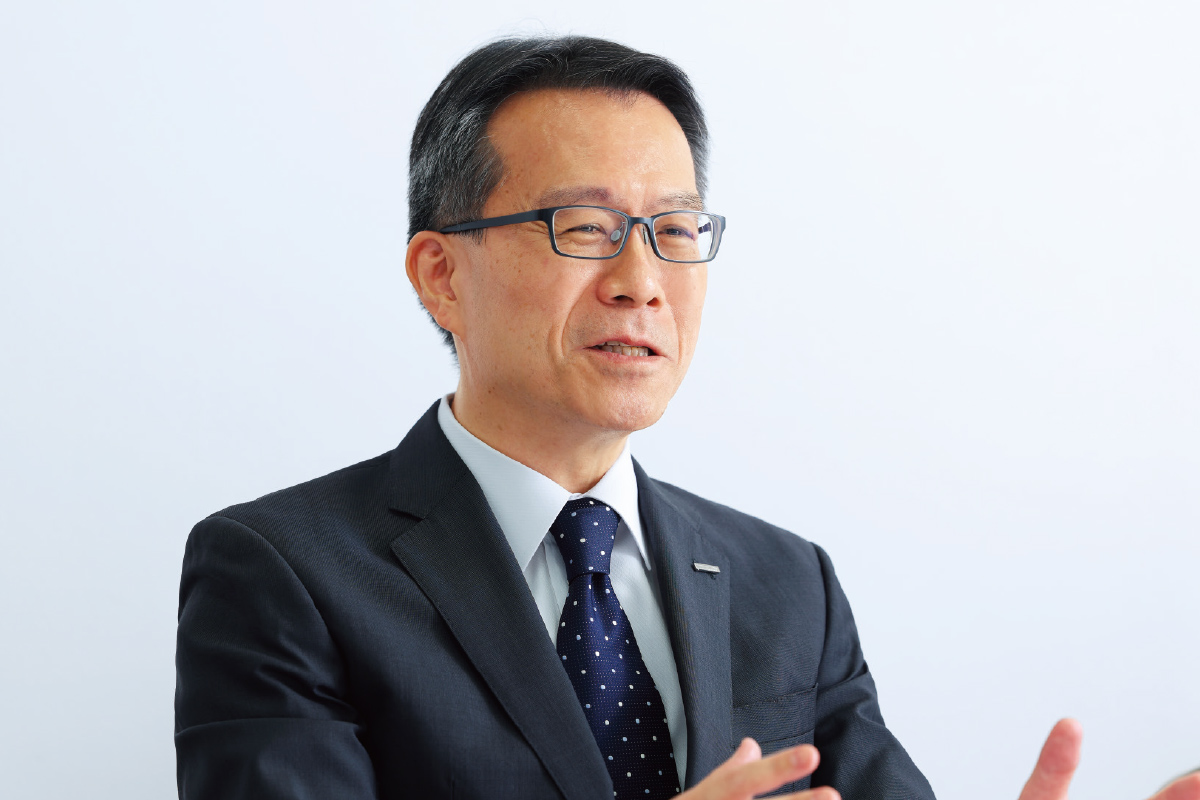
 Improvement of the Board’s Diversity
Improvement of the Board’s Diversity
Kuwabara:The selection process for the two new directors was the same as that for the president and vice president. Director and CFO Takashi Tsuji has personally supported me in various ways in matters related to the Board of Directors, so I have a good understanding of his character. In addition, I believe that Director Noriko Fujita was appropriately appointed in line with the major goal of enhancing corporate functions.
Kawana:I have had numerous opportunities in the past to speak with Mr. Tsuji, and I find him to be a grounded and trustworthy individual. Ms. Fujita also has a great reputation within the Company, and she strikes me as a highly serious and capable individual. The Personnel Committee has interviewed newly appointed directors at each operating company, many of whom are very unique and charismatic, which makes me truly feel that the Group has an abundance of outstanding talent. This pool of talent is, in a way, the embodiment of the “same spirit, diverse talents” concept.
Shimada:I have met with Ms. Fujita many times through next-generation leadership development programs, and I interviewed her when she became a director at Bandai Co., Ltd. Based on my interactions with her, I have high expectations for her contributions moving forward. I view the recent appointments positively overall, especially in terms of improving Board diversity.
Shinoda:With the new appointments,I feel the Group has in place an optimal structure for promoting the current Mid-term Plan, under which it aims to shore up its foundation for sustainable growth.
Kuwabara:I was very impressed to see the appointment of a second female internal director following Nao Udagawa. Both of these individuals moved up the ranks through their excellent capabilities, and their presence on the Board signals a strong message in support of the active role of women in management moving forward. In terms of our succession plan, we are continuing to develop next-generation leadership by categorizing candidates into three generational tiers. The Personnel Committee receives an annual progress report and engages in ongoing discussions based on these reports. I feel that we have achieved steady results with our succession efforts, as demonstrated by the growing talent pool year by year and the increase in the ratio of women in the younger tiers.
Shimada:If we can start engaging in more substantial discussions on our long-term vision, I believe we can start adopting a backcasting approach to defining talent requirements. The qualities needed for leadership in the future likely differ from those needed today, and there will also come a time when we will have to review the overall composition of the Board itself.
 Insight on the Revision to the Officer Remuneration System
Insight on the Revision to the Officer Remuneration System
Shimada:On the subject of the officer remuneration system, we have been examining the adoption of new financial indicators linked with share price to serve as a KPI for variable remuneration alongside consolidated operating profit. Personally, I was thinking this indicator ought to be market capitalization, which has a direct link with share price, but we ended up deciding to adopt earnings per share (EPS) instead. EPS is closely related to share price, so I believe its adoption as an indicator represents a significant step forward.
We also narrowed the sustainability evaluation items down to two: carbon neutrality and employee engagement. The sustainability evaluation score for FY2025.3, the third year since this evaluation was introduced, was “neutral.”
Kawana:By nature, sustainability evaluation scores are relatively rigid and not prone to frequent changes. In FY2024.3, the second year of the sustainability evaluation , we raised the score by one level in recognition of the establishment of a framework for sustainability initiatives. However, in the third year—effectively the first year of the execution phase —we set the score back to “neutral.”
Kuwabara:Simply introducing a sustainability evaluation sends an important message externally. However, in practice, this evaluation involves many items, and as such overall scores tend to result in “neutral.” Thus, to enhance the effectiveness of the evaluation as a performance indicator and provide greater clarity and distinction, we narrowed down the evaluation items.
There are companies that make use of total shareholder return (TSR) as a financial KPI with an awareness of the stock market. However, since such indicators can be influenced by overall market trends, we chose EPS instead, as it more accurately reflects company-specific performance. By adopting EPS as an indicator, we are required to be more mindful of our approach to shareholder returns, including the acquisition of treasury shares. In that sense, I believe EPS provides an important perspective.
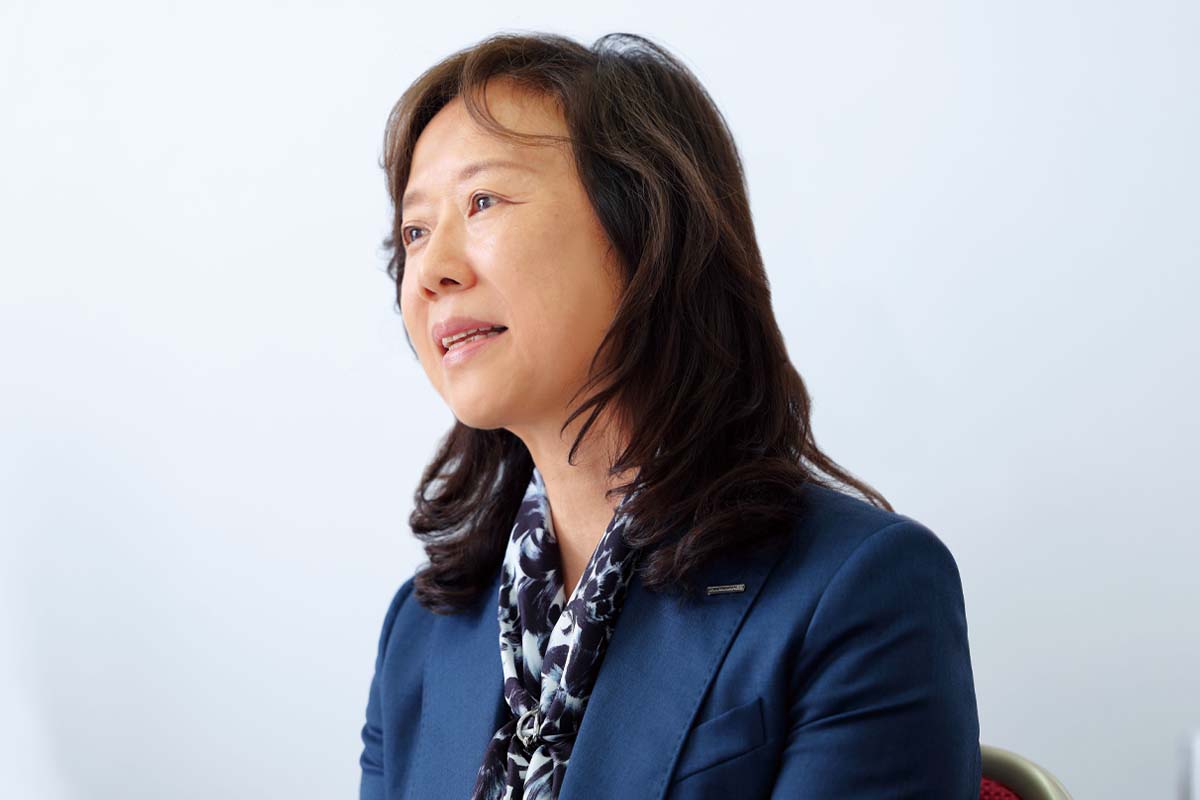
 Expectations for Outside Directors
Expectations for Outside Directors
Shimada:As the social expectations toward outside directors continue to increase, I constantly ask myself what my personal role ought to be. In my view, I believe that an outside director needs to be able to ask good questions. With this in mind, I make concerted efforts to share my candid thoughts on agenda items at Board meetings and offer perspectives from different angles. By raising questions that prompt the executive side to pause for a moment and consider different perspectives, even to a small extent, I will fulfill my responsibility as an outside director that acts as a proxy for investors.
Kawana:The role of an outside director is to provide support so that the Board of Directors can grow into a sound decision-making body and exercise its governance function accordingly. We ourselves do not take direct action. Instead, we seek to engage with the executive side and encourage them to make new realizations. For this reason, outside directors also must value a certain level of subtle discomfort, which comes from having worked in different industries, so that we can voice our opinions without hesitation when something needs to be said. The Board of Directors provides an open and accepting environment that encourages this kind of honest expression. In this setting, I will contribute to the Board’s continued growth by engaging sincerely as my authentic self.
Shinoda:At Board meetings, I make various comments from the standpoint of emphasizing the establishment of a stable earnings base with a focus on corporate functions that form the basis of all agenda items. In addition, as an Audit & Supervisory Committee member, I actively conduct information security audits. At the same time, a difficult question remains: might this kind of approach hinder the open and free pursuit of challenges that defines Bandai Namco’s uniqueness? Finding the optimal balance between oversight and freedom is not easy. While I do not claim to have the answer myself, I intend to keep a close watch on how the executive side approaches this issue and give consideration to it as a starting point for conducting audits.
Kuwabara:Maintaining an understanding and respect for the unique nature of Bandai Namco can sometimes clash with the needs of the market. As outside directors, I believe we can bridge the gap between these two important requirements. Rather than accepting everything as long as it is unique to Bandai Namco, I hope that we can deepen discussions and work together with internal directors to pursue true best practices. Furthermore, drawing on the large volume of information I have access to as an Audit & Supervisory Committee member,I will make suggestions to the executive side promptly if I notice something that seems amiss.
Komiya:Based on my experience at other companies in the entertainment industry, I believe that the governance of the Bandai Namco Group functions at a very high level compared with that of the average entertainment company. I believe this likely reflects the success of Mr. Asako’s leadership thus far. In any case, I aim to further refine the advantages provided by this robust governance by strengthening both the front- and back-office operations in a well-balanced manner and helping Bandai Namco grow into an even stronger company.
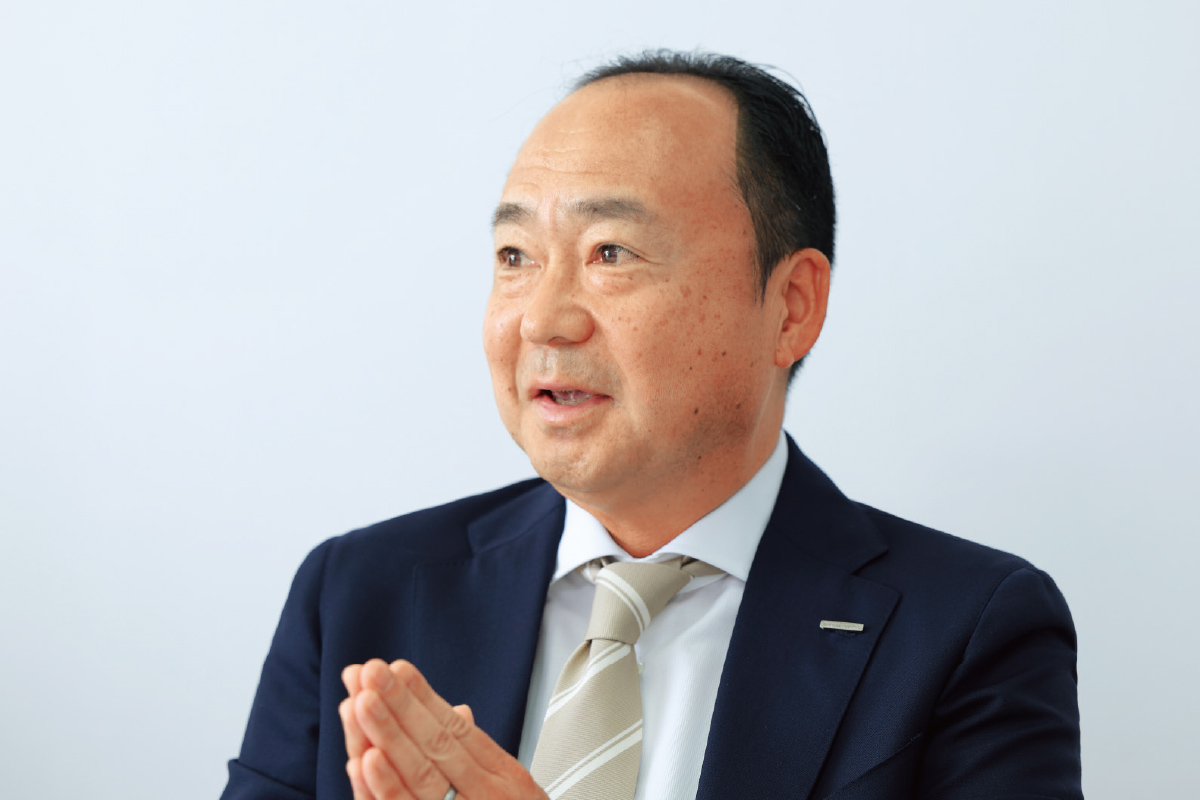
What Purpose Means to Me
ShimadaI believe that Bandai Namco’s Purpose represents the Company’s deep commitment to providing fans with fun and excitement on an ongoing basis.I hope for the day when we see a world that is centered on “Connecting people and societies.” I look forward to Bandai Namco playing a significant role in making that world a reality and becoming a shining presence within it.
KawanaI hope for the day when we see a world that is centered on “Connecting people and societies.” I look forward to Bandai Namco playing a significant role in making that world a reality and becoming a shining presence within it.
ShinodaBy pursuing “dreams, fun and inspiration,” we are making connections with people to pursue co-creation. Our Purpose clearly expresses the tremendous potential of entertainment to deliver value, due precisely to the fact that it is not a daily necessity.
KuwabaraIn an era of increasing global division, I see Bandai Namco’s Purpose as a reflection of the growing importance of utilizing the power of entertainment to create a future filled with smiles.
KomiyaMeeting the expectations of fans is an essential part of realizing our Purpose. To that end, the Company must seek to understand what those expectations are and work to sincerely meet them.


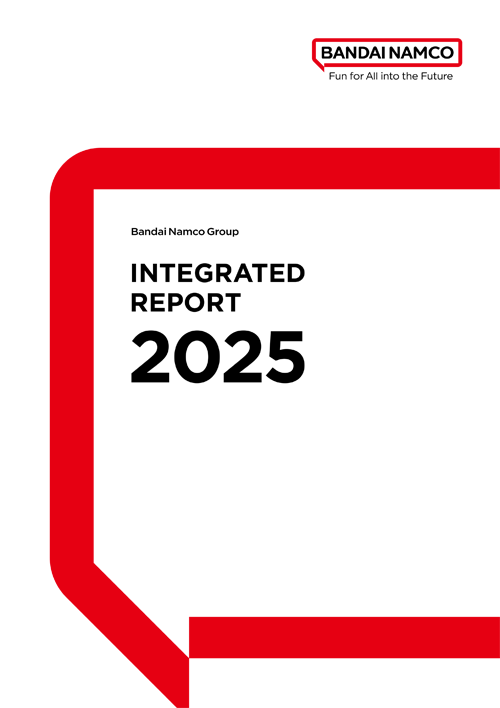

 CHAIRMAN’S MESSAGE/PRESIDENT’S MESSAGE
CHAIRMAN’S MESSAGE/PRESIDENT’S MESSAGE Integrated Report 2025
Integrated Report 2025 16.8 MB
16.8 MB MAJOR IPS IN GROUP PRODUCTS AND SERVICES
MAJOR IPS IN GROUP PRODUCTS AND SERVICES